Report on Travel and Tourism Sector: Historical Analysis and Impacts
VerifiedAdded on 2020/01/07
|18
|4619
|297
Report
AI Summary
This report provides a comprehensive overview of the travel and tourism sector, commencing with its historical development, tracing back to ancient times and detailing key periods such as before 1945, 1945-1979, and 1980 to the present day. It explores the structure of the industry, including the Leiper's Model and its components: departing travelers, traveler generating regions, transit route regions, tourist destination regions, and returning travelers, along with the six sectors of the industry, including attractions, transport, accommodation, tour operators, travel agents, and tourism development. The report further analyzes the functions of governments, government-sponsored bodies, and international agencies within the sector and assesses the implications of political change on the travel and tourism sector, using examples from various countries. It also examines factors affecting tourism demand and supply, including how supply has changed at TUI Group to meet demand, and evaluates the positive and negative economic, environmental, and social impacts of tourism, particularly concerning TUI Group businesses, along with strategies to mitigate negative impacts and maximize positive ones.
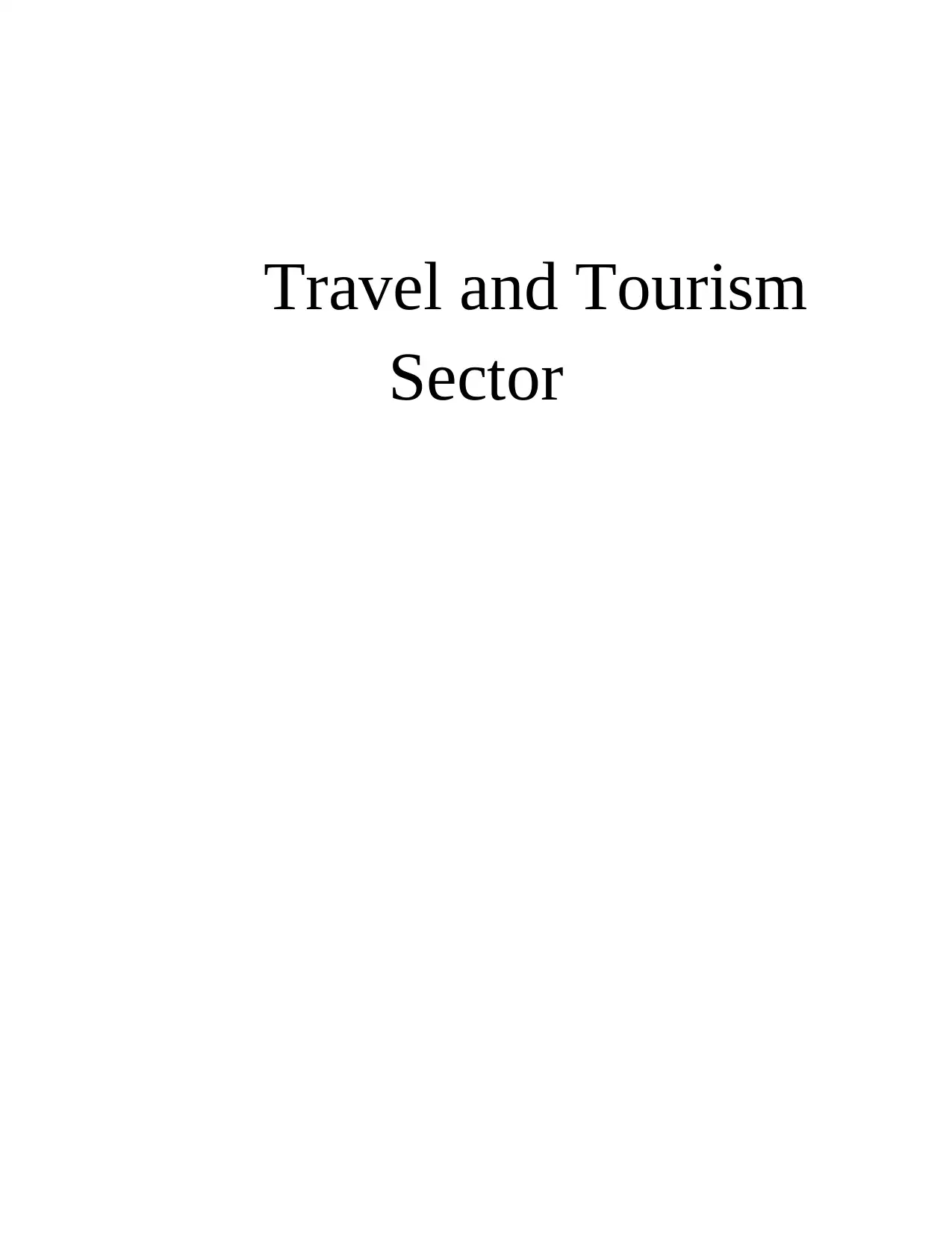
Travel and Tourism
Sector
Sector
Paraphrase This Document
Need a fresh take? Get an instant paraphrase of this document with our AI Paraphraser
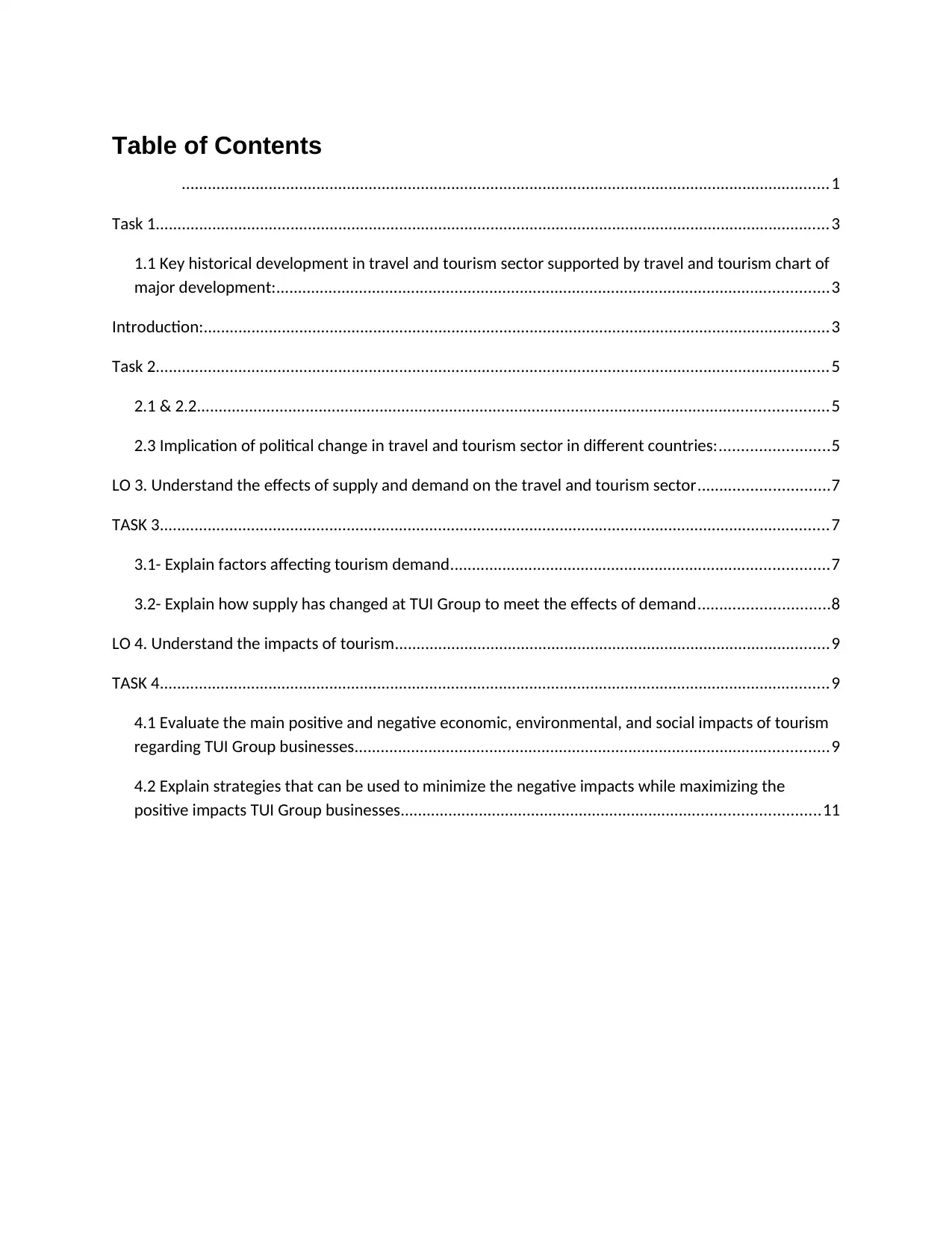
Table of Contents
.....................................................................................................................................................1
Task 1...........................................................................................................................................................3
1.1 Key historical development in travel and tourism sector supported by travel and tourism chart of
major development:...............................................................................................................................3
Introduction:................................................................................................................................................3
Task 2...........................................................................................................................................................5
2.1 & 2.2.................................................................................................................................................5
2.3 Implication of political change in travel and tourism sector in different countries:.........................5
LO 3. Understand the effects of supply and demand on the travel and tourism sector..............................7
TASK 3..........................................................................................................................................................7
3.1- Explain factors affecting tourism demand.......................................................................................7
3.2- Explain how supply has changed at TUI Group to meet the effects of demand..............................8
LO 4. Understand the impacts of tourism....................................................................................................9
TASK 4..........................................................................................................................................................9
4.1 Evaluate the main positive and negative economic, environmental, and social impacts of tourism
regarding TUI Group businesses.............................................................................................................9
4.2 Explain strategies that can be used to minimize the negative impacts while maximizing the
positive impacts TUI Group businesses................................................................................................11
.....................................................................................................................................................1
Task 1...........................................................................................................................................................3
1.1 Key historical development in travel and tourism sector supported by travel and tourism chart of
major development:...............................................................................................................................3
Introduction:................................................................................................................................................3
Task 2...........................................................................................................................................................5
2.1 & 2.2.................................................................................................................................................5
2.3 Implication of political change in travel and tourism sector in different countries:.........................5
LO 3. Understand the effects of supply and demand on the travel and tourism sector..............................7
TASK 3..........................................................................................................................................................7
3.1- Explain factors affecting tourism demand.......................................................................................7
3.2- Explain how supply has changed at TUI Group to meet the effects of demand..............................8
LO 4. Understand the impacts of tourism....................................................................................................9
TASK 4..........................................................................................................................................................9
4.1 Evaluate the main positive and negative economic, environmental, and social impacts of tourism
regarding TUI Group businesses.............................................................................................................9
4.2 Explain strategies that can be used to minimize the negative impacts while maximizing the
positive impacts TUI Group businesses................................................................................................11
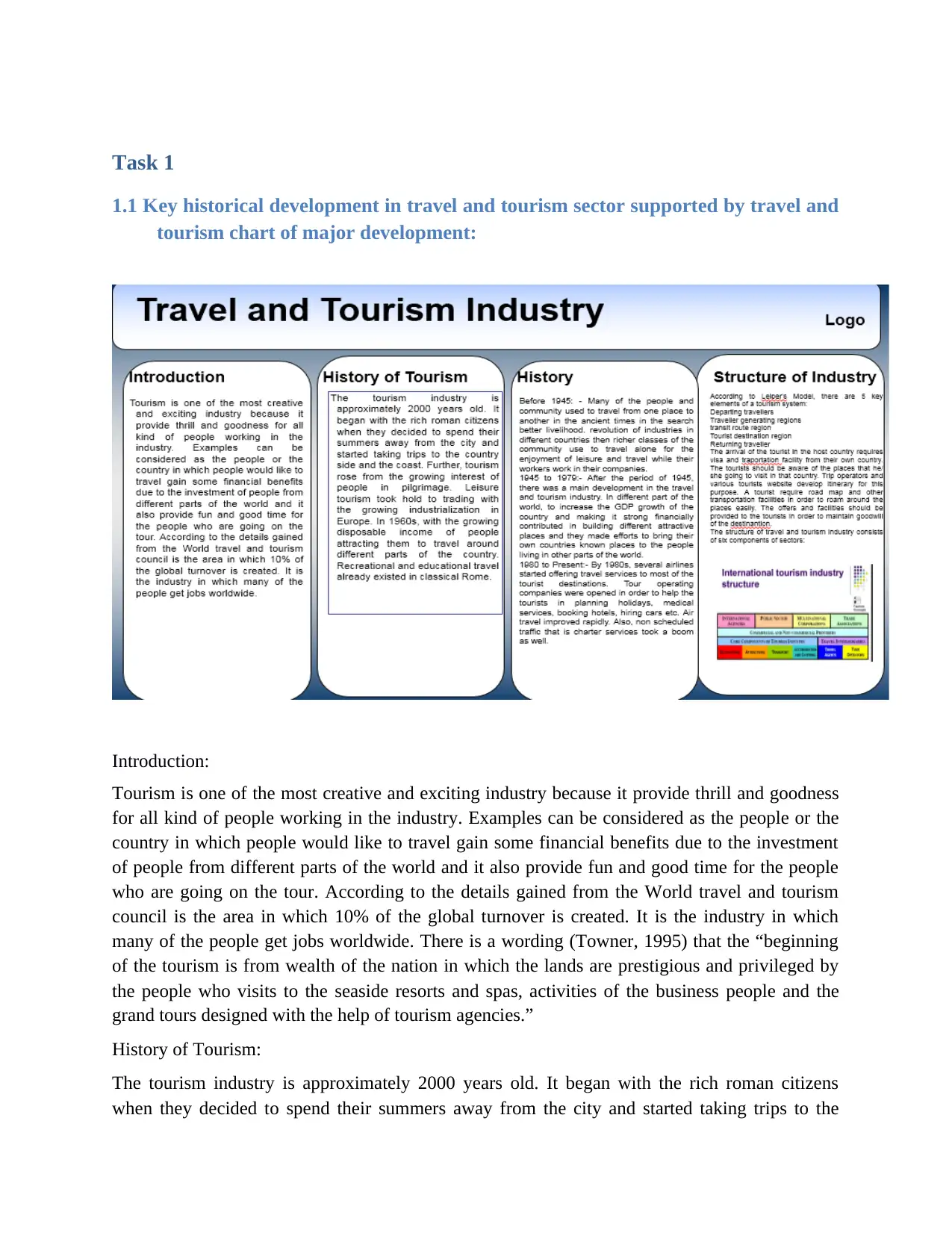
Task 1
1.1 Key historical development in travel and tourism sector supported by travel and
tourism chart of major development:
Introduction:
Tourism is one of the most creative and exciting industry because it provide thrill and goodness
for all kind of people working in the industry. Examples can be considered as the people or the
country in which people would like to travel gain some financial benefits due to the investment
of people from different parts of the world and it also provide fun and good time for the people
who are going on the tour. According to the details gained from the World travel and tourism
council is the area in which 10% of the global turnover is created. It is the industry in which
many of the people get jobs worldwide. There is a wording (Towner, 1995) that the “beginning
of the tourism is from wealth of the nation in which the lands are prestigious and privileged by
the people who visits to the seaside resorts and spas, activities of the business people and the
grand tours designed with the help of tourism agencies.”
History of Tourism:
The tourism industry is approximately 2000 years old. It began with the rich roman citizens
when they decided to spend their summers away from the city and started taking trips to the
1.1 Key historical development in travel and tourism sector supported by travel and
tourism chart of major development:
Introduction:
Tourism is one of the most creative and exciting industry because it provide thrill and goodness
for all kind of people working in the industry. Examples can be considered as the people or the
country in which people would like to travel gain some financial benefits due to the investment
of people from different parts of the world and it also provide fun and good time for the people
who are going on the tour. According to the details gained from the World travel and tourism
council is the area in which 10% of the global turnover is created. It is the industry in which
many of the people get jobs worldwide. There is a wording (Towner, 1995) that the “beginning
of the tourism is from wealth of the nation in which the lands are prestigious and privileged by
the people who visits to the seaside resorts and spas, activities of the business people and the
grand tours designed with the help of tourism agencies.”
History of Tourism:
The tourism industry is approximately 2000 years old. It began with the rich roman citizens
when they decided to spend their summers away from the city and started taking trips to the
⊘ This is a preview!⊘
Do you want full access?
Subscribe today to unlock all pages.

Trusted by 1+ million students worldwide
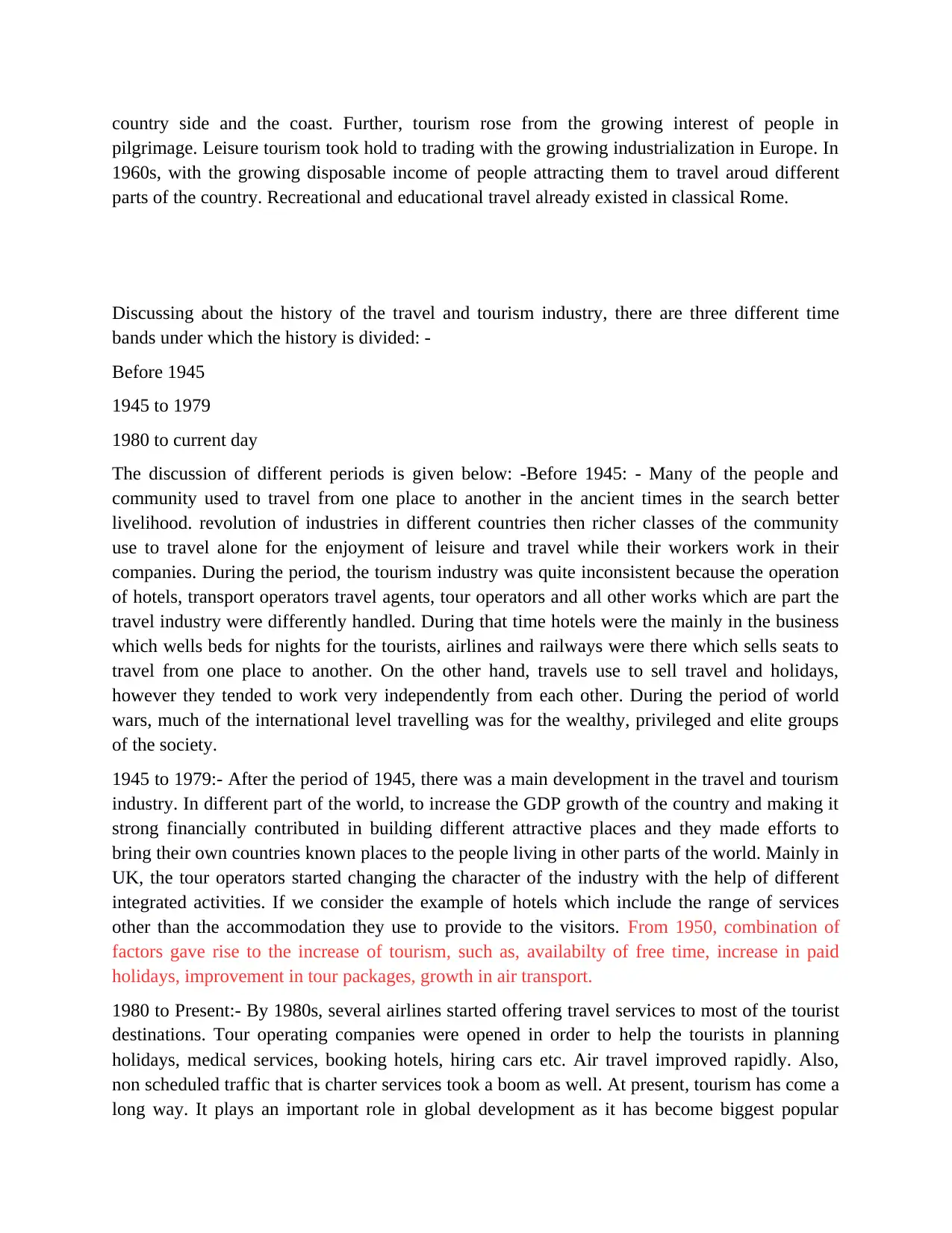
country side and the coast. Further, tourism rose from the growing interest of people in
pilgrimage. Leisure tourism took hold to trading with the growing industrialization in Europe. In
1960s, with the growing disposable income of people attracting them to travel aroud different
parts of the country. Recreational and educational travel already existed in classical Rome.
Discussing about the history of the travel and tourism industry, there are three different time
bands under which the history is divided: -
Before 1945
1945 to 1979
1980 to current day
The discussion of different periods is given below: -Before 1945: - Many of the people and
community used to travel from one place to another in the ancient times in the search better
livelihood. revolution of industries in different countries then richer classes of the community
use to travel alone for the enjoyment of leisure and travel while their workers work in their
companies. During the period, the tourism industry was quite inconsistent because the operation
of hotels, transport operators travel agents, tour operators and all other works which are part the
travel industry were differently handled. During that time hotels were the mainly in the business
which wells beds for nights for the tourists, airlines and railways were there which sells seats to
travel from one place to another. On the other hand, travels use to sell travel and holidays,
however they tended to work very independently from each other. During the period of world
wars, much of the international level travelling was for the wealthy, privileged and elite groups
of the society.
1945 to 1979:- After the period of 1945, there was a main development in the travel and tourism
industry. In different part of the world, to increase the GDP growth of the country and making it
strong financially contributed in building different attractive places and they made efforts to
bring their own countries known places to the people living in other parts of the world. Mainly in
UK, the tour operators started changing the character of the industry with the help of different
integrated activities. If we consider the example of hotels which include the range of services
other than the accommodation they use to provide to the visitors. From 1950, combination of
factors gave rise to the increase of tourism, such as, availabilty of free time, increase in paid
holidays, improvement in tour packages, growth in air transport.
1980 to Present:- By 1980s, several airlines started offering travel services to most of the tourist
destinations. Tour operating companies were opened in order to help the tourists in planning
holidays, medical services, booking hotels, hiring cars etc. Air travel improved rapidly. Also,
non scheduled traffic that is charter services took a boom as well. At present, tourism has come a
long way. It plays an important role in global development as it has become biggest popular
pilgrimage. Leisure tourism took hold to trading with the growing industrialization in Europe. In
1960s, with the growing disposable income of people attracting them to travel aroud different
parts of the country. Recreational and educational travel already existed in classical Rome.
Discussing about the history of the travel and tourism industry, there are three different time
bands under which the history is divided: -
Before 1945
1945 to 1979
1980 to current day
The discussion of different periods is given below: -Before 1945: - Many of the people and
community used to travel from one place to another in the ancient times in the search better
livelihood. revolution of industries in different countries then richer classes of the community
use to travel alone for the enjoyment of leisure and travel while their workers work in their
companies. During the period, the tourism industry was quite inconsistent because the operation
of hotels, transport operators travel agents, tour operators and all other works which are part the
travel industry were differently handled. During that time hotels were the mainly in the business
which wells beds for nights for the tourists, airlines and railways were there which sells seats to
travel from one place to another. On the other hand, travels use to sell travel and holidays,
however they tended to work very independently from each other. During the period of world
wars, much of the international level travelling was for the wealthy, privileged and elite groups
of the society.
1945 to 1979:- After the period of 1945, there was a main development in the travel and tourism
industry. In different part of the world, to increase the GDP growth of the country and making it
strong financially contributed in building different attractive places and they made efforts to
bring their own countries known places to the people living in other parts of the world. Mainly in
UK, the tour operators started changing the character of the industry with the help of different
integrated activities. If we consider the example of hotels which include the range of services
other than the accommodation they use to provide to the visitors. From 1950, combination of
factors gave rise to the increase of tourism, such as, availabilty of free time, increase in paid
holidays, improvement in tour packages, growth in air transport.
1980 to Present:- By 1980s, several airlines started offering travel services to most of the tourist
destinations. Tour operating companies were opened in order to help the tourists in planning
holidays, medical services, booking hotels, hiring cars etc. Air travel improved rapidly. Also,
non scheduled traffic that is charter services took a boom as well. At present, tourism has come a
long way. It plays an important role in global development as it has become biggest popular
Paraphrase This Document
Need a fresh take? Get an instant paraphrase of this document with our AI Paraphraser
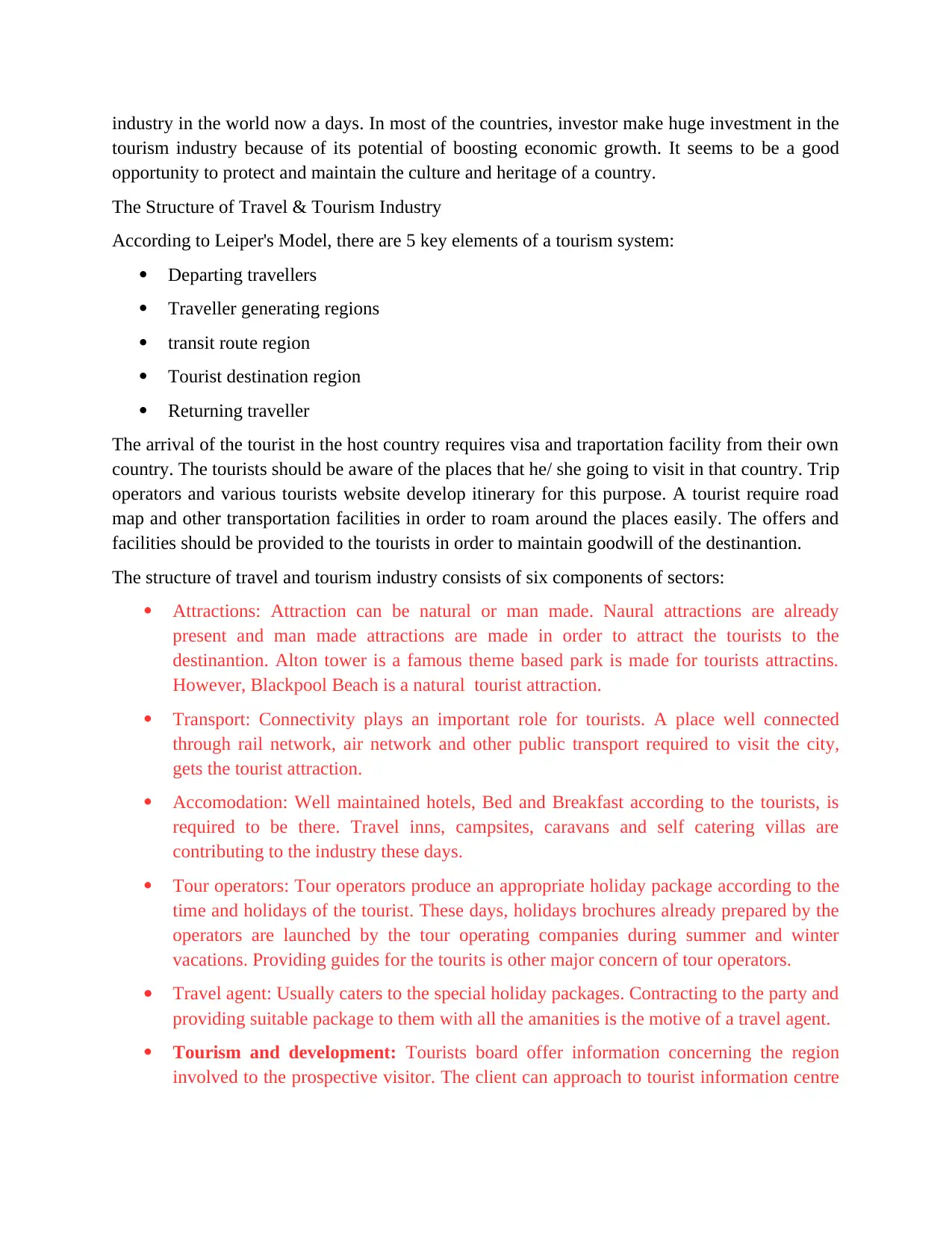
industry in the world now a days. In most of the countries, investor make huge investment in the
tourism industry because of its potential of boosting economic growth. It seems to be a good
opportunity to protect and maintain the culture and heritage of a country.
The Structure of Travel & Tourism Industry
According to Leiper's Model, there are 5 key elements of a tourism system:
Departing travellers
Traveller generating regions
transit route region
Tourist destination region
Returning traveller
The arrival of the tourist in the host country requires visa and traportation facility from their own
country. The tourists should be aware of the places that he/ she going to visit in that country. Trip
operators and various tourists website develop itinerary for this purpose. A tourist require road
map and other transportation facilities in order to roam around the places easily. The offers and
facilities should be provided to the tourists in order to maintain goodwill of the destinantion.
The structure of travel and tourism industry consists of six components of sectors:
Attractions: Attraction can be natural or man made. Naural attractions are already
present and man made attractions are made in order to attract the tourists to the
destinantion. Alton tower is a famous theme based park is made for tourists attractins.
However, Blackpool Beach is a natural tourist attraction.
Transport: Connectivity plays an important role for tourists. A place well connected
through rail network, air network and other public transport required to visit the city,
gets the tourist attraction.
Accomodation: Well maintained hotels, Bed and Breakfast according to the tourists, is
required to be there. Travel inns, campsites, caravans and self catering villas are
contributing to the industry these days.
Tour operators: Tour operators produce an appropriate holiday package according to the
time and holidays of the tourist. These days, holidays brochures already prepared by the
operators are launched by the tour operating companies during summer and winter
vacations. Providing guides for the tourits is other major concern of tour operators.
Travel agent: Usually caters to the special holiday packages. Contracting to the party and
providing suitable package to them with all the amanities is the motive of a travel agent.
Tourism and development: Tourists board offer information concerning the region
involved to the prospective visitor. The client can approach to tourist information centre
tourism industry because of its potential of boosting economic growth. It seems to be a good
opportunity to protect and maintain the culture and heritage of a country.
The Structure of Travel & Tourism Industry
According to Leiper's Model, there are 5 key elements of a tourism system:
Departing travellers
Traveller generating regions
transit route region
Tourist destination region
Returning traveller
The arrival of the tourist in the host country requires visa and traportation facility from their own
country. The tourists should be aware of the places that he/ she going to visit in that country. Trip
operators and various tourists website develop itinerary for this purpose. A tourist require road
map and other transportation facilities in order to roam around the places easily. The offers and
facilities should be provided to the tourists in order to maintain goodwill of the destinantion.
The structure of travel and tourism industry consists of six components of sectors:
Attractions: Attraction can be natural or man made. Naural attractions are already
present and man made attractions are made in order to attract the tourists to the
destinantion. Alton tower is a famous theme based park is made for tourists attractins.
However, Blackpool Beach is a natural tourist attraction.
Transport: Connectivity plays an important role for tourists. A place well connected
through rail network, air network and other public transport required to visit the city,
gets the tourist attraction.
Accomodation: Well maintained hotels, Bed and Breakfast according to the tourists, is
required to be there. Travel inns, campsites, caravans and self catering villas are
contributing to the industry these days.
Tour operators: Tour operators produce an appropriate holiday package according to the
time and holidays of the tourist. These days, holidays brochures already prepared by the
operators are launched by the tour operating companies during summer and winter
vacations. Providing guides for the tourits is other major concern of tour operators.
Travel agent: Usually caters to the special holiday packages. Contracting to the party and
providing suitable package to them with all the amanities is the motive of a travel agent.
Tourism and development: Tourists board offer information concerning the region
involved to the prospective visitor. The client can approach to tourist information centre
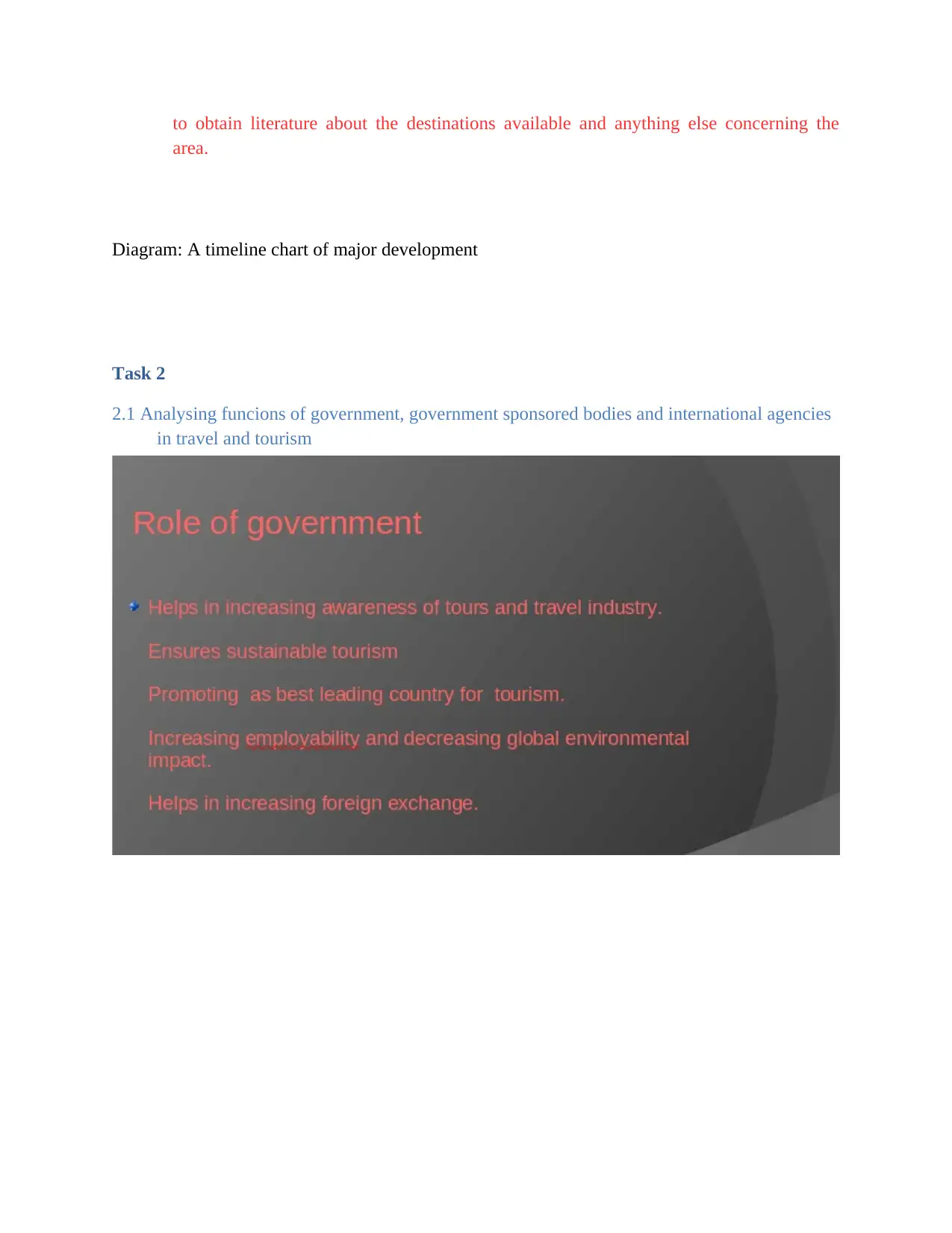
to obtain literature about the destinations available and anything else concerning the
area.
Diagram: A timeline chart of major development
Task 2
2.1 Analysing funcions of government, government sponsored bodies and international agencies
in travel and tourism
area.
Diagram: A timeline chart of major development
Task 2
2.1 Analysing funcions of government, government sponsored bodies and international agencies
in travel and tourism
⊘ This is a preview!⊘
Do you want full access?
Subscribe today to unlock all pages.

Trusted by 1+ million students worldwide
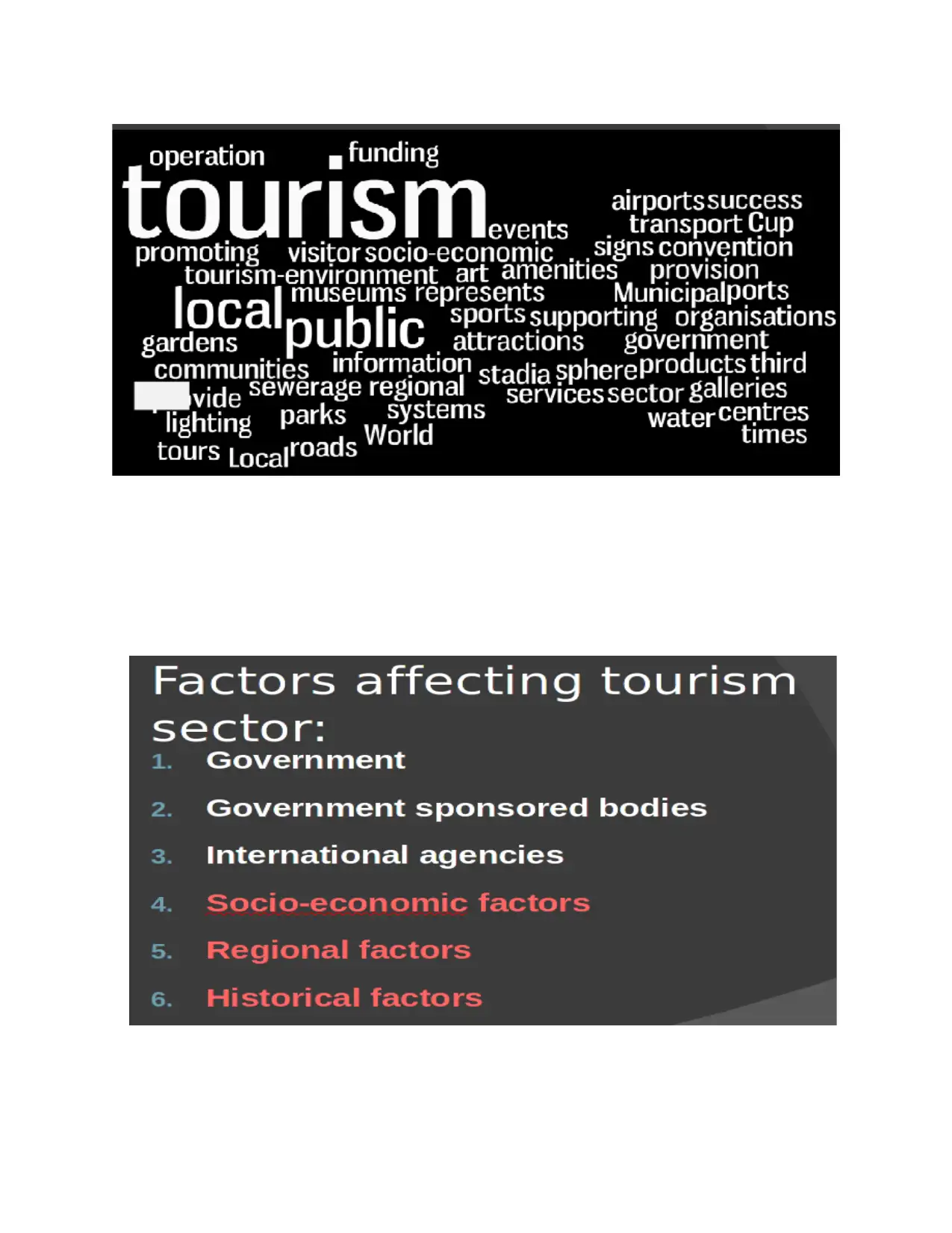
Paraphrase This Document
Need a fresh take? Get an instant paraphrase of this document with our AI Paraphraser
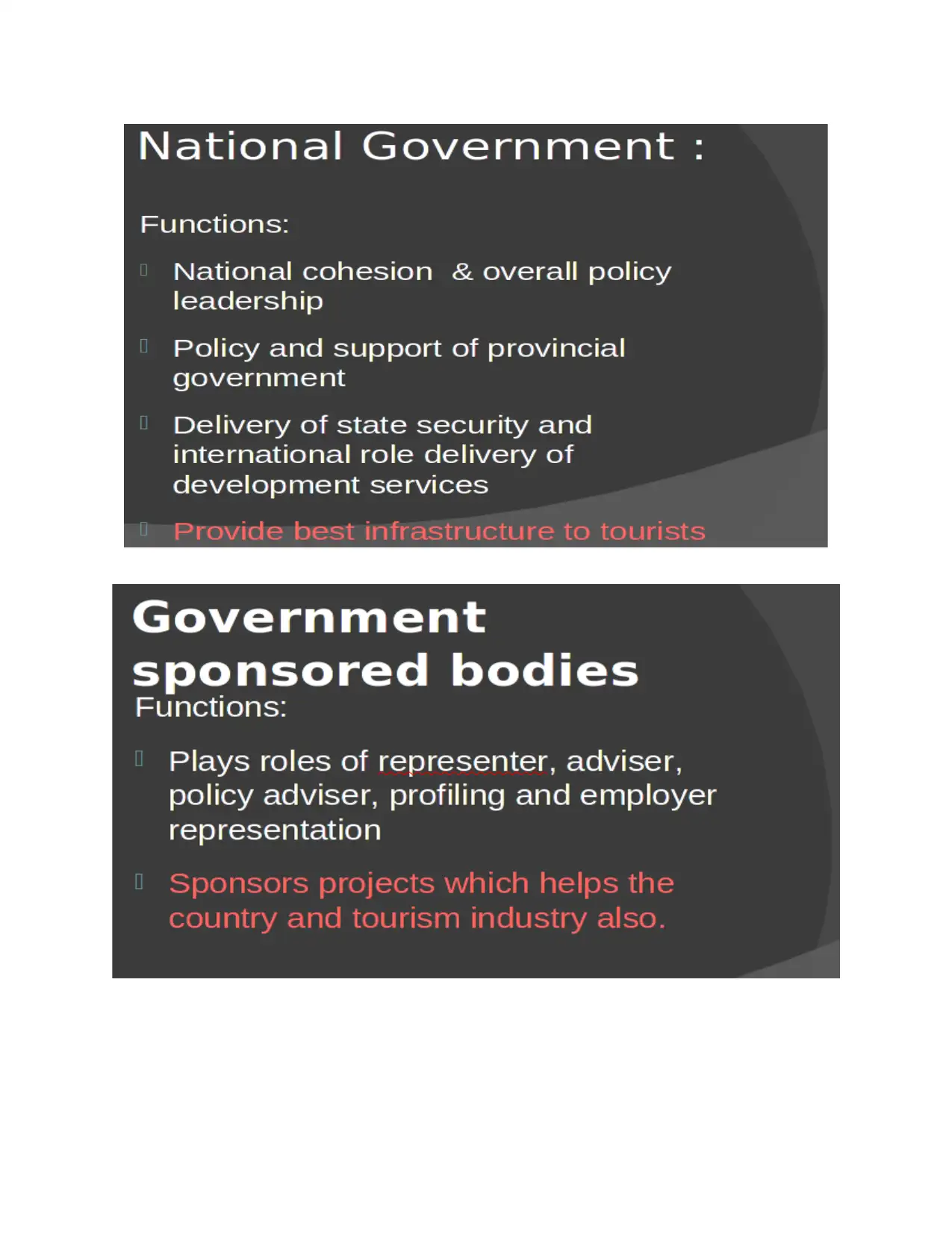
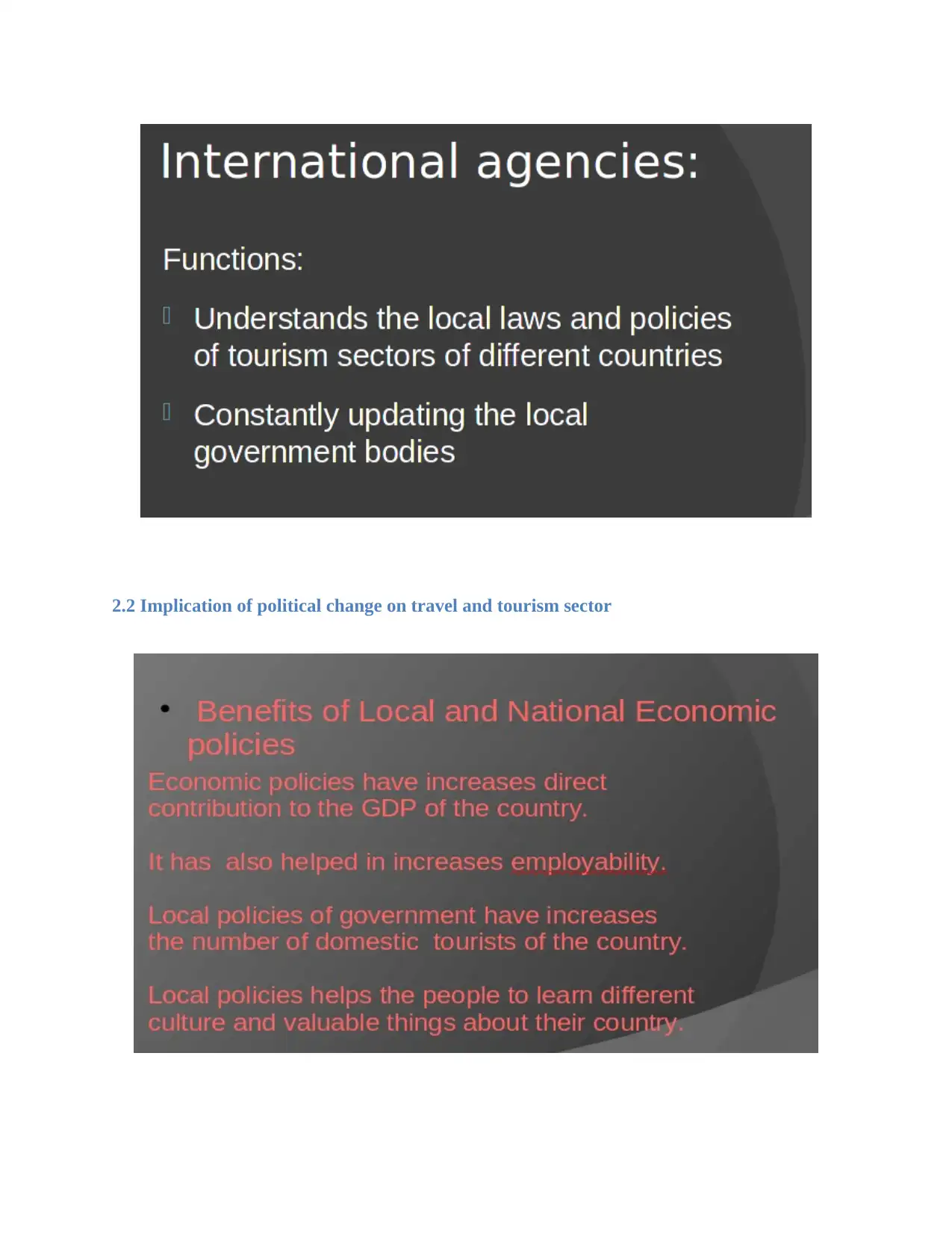
2.2 Implication of political change on travel and tourism sector
⊘ This is a preview!⊘
Do you want full access?
Subscribe today to unlock all pages.

Trusted by 1+ million students worldwide
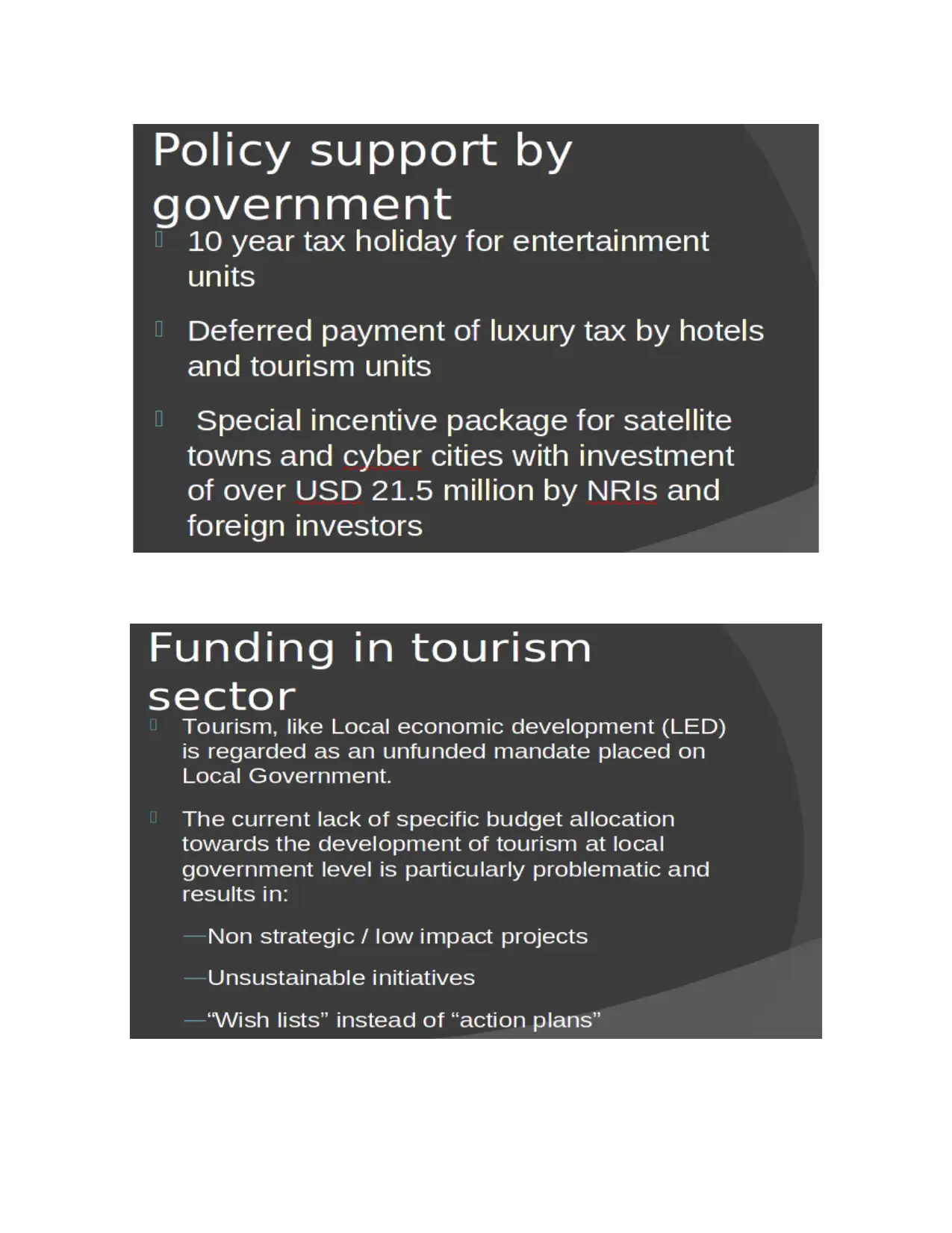
Paraphrase This Document
Need a fresh take? Get an instant paraphrase of this document with our AI Paraphraser
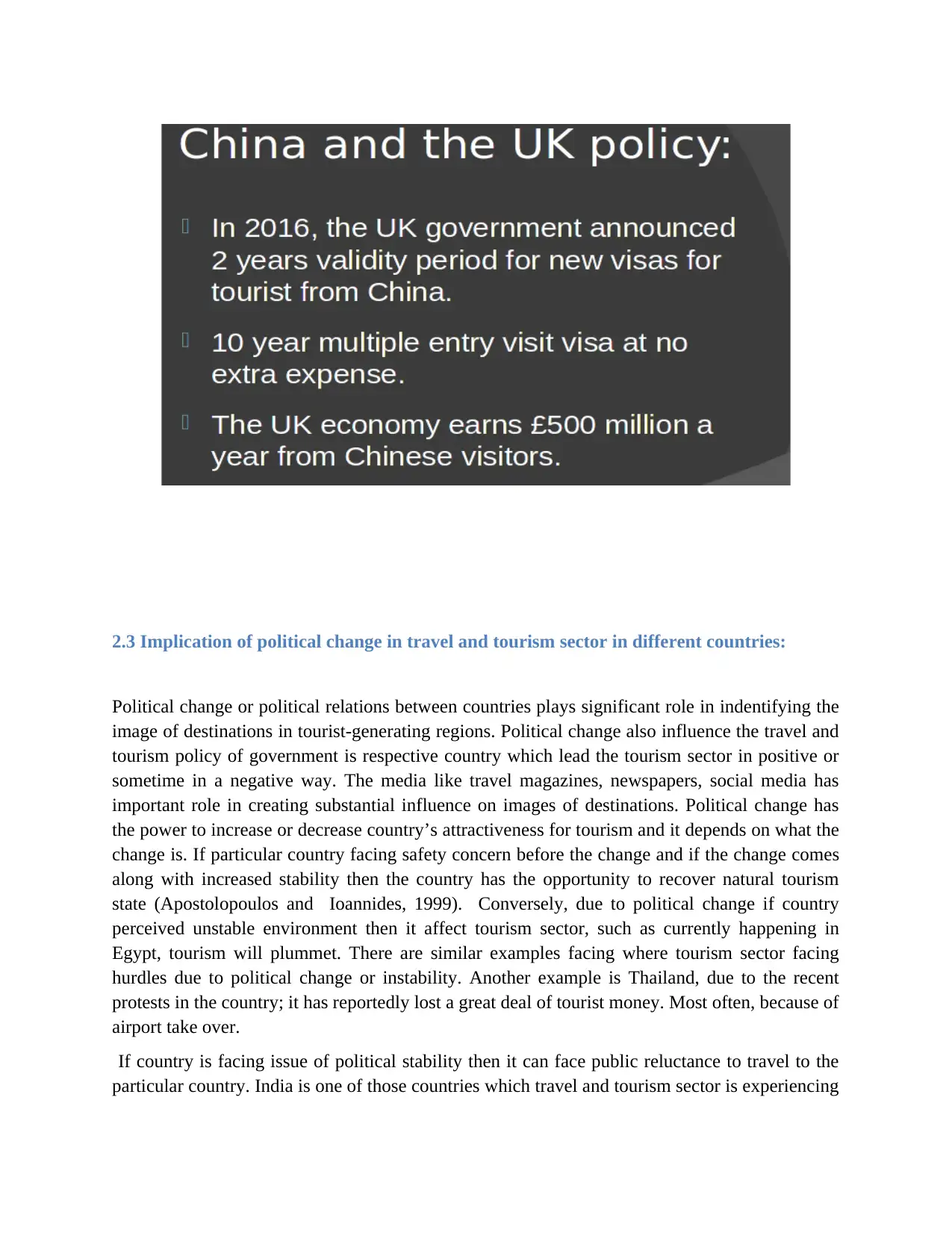
2.3 Implication of political change in travel and tourism sector in different countries:
Political change or political relations between countries plays significant role in indentifying the
image of destinations in tourist-generating regions. Political change also influence the travel and
tourism policy of government is respective country which lead the tourism sector in positive or
sometime in a negative way. The media like travel magazines, newspapers, social media has
important role in creating substantial influence on images of destinations. Political change has
the power to increase or decrease country’s attractiveness for tourism and it depends on what the
change is. If particular country facing safety concern before the change and if the change comes
along with increased stability then the country has the opportunity to recover natural tourism
state (Apostolopoulos and Ioannides, 1999). Conversely, due to political change if country
perceived unstable environment then it affect tourism sector, such as currently happening in
Egypt, tourism will plummet. There are similar examples facing where tourism sector facing
hurdles due to political change or instability. Another example is Thailand, due to the recent
protests in the country; it has reportedly lost a great deal of tourist money. Most often, because of
airport take over.
If country is facing issue of political stability then it can face public reluctance to travel to the
particular country. India is one of those countries which travel and tourism sector is experiencing
Political change or political relations between countries plays significant role in indentifying the
image of destinations in tourist-generating regions. Political change also influence the travel and
tourism policy of government is respective country which lead the tourism sector in positive or
sometime in a negative way. The media like travel magazines, newspapers, social media has
important role in creating substantial influence on images of destinations. Political change has
the power to increase or decrease country’s attractiveness for tourism and it depends on what the
change is. If particular country facing safety concern before the change and if the change comes
along with increased stability then the country has the opportunity to recover natural tourism
state (Apostolopoulos and Ioannides, 1999). Conversely, due to political change if country
perceived unstable environment then it affect tourism sector, such as currently happening in
Egypt, tourism will plummet. There are similar examples facing where tourism sector facing
hurdles due to political change or instability. Another example is Thailand, due to the recent
protests in the country; it has reportedly lost a great deal of tourist money. Most often, because of
airport take over.
If country is facing issue of political stability then it can face public reluctance to travel to the
particular country. India is one of those countries which travel and tourism sector is experiencing
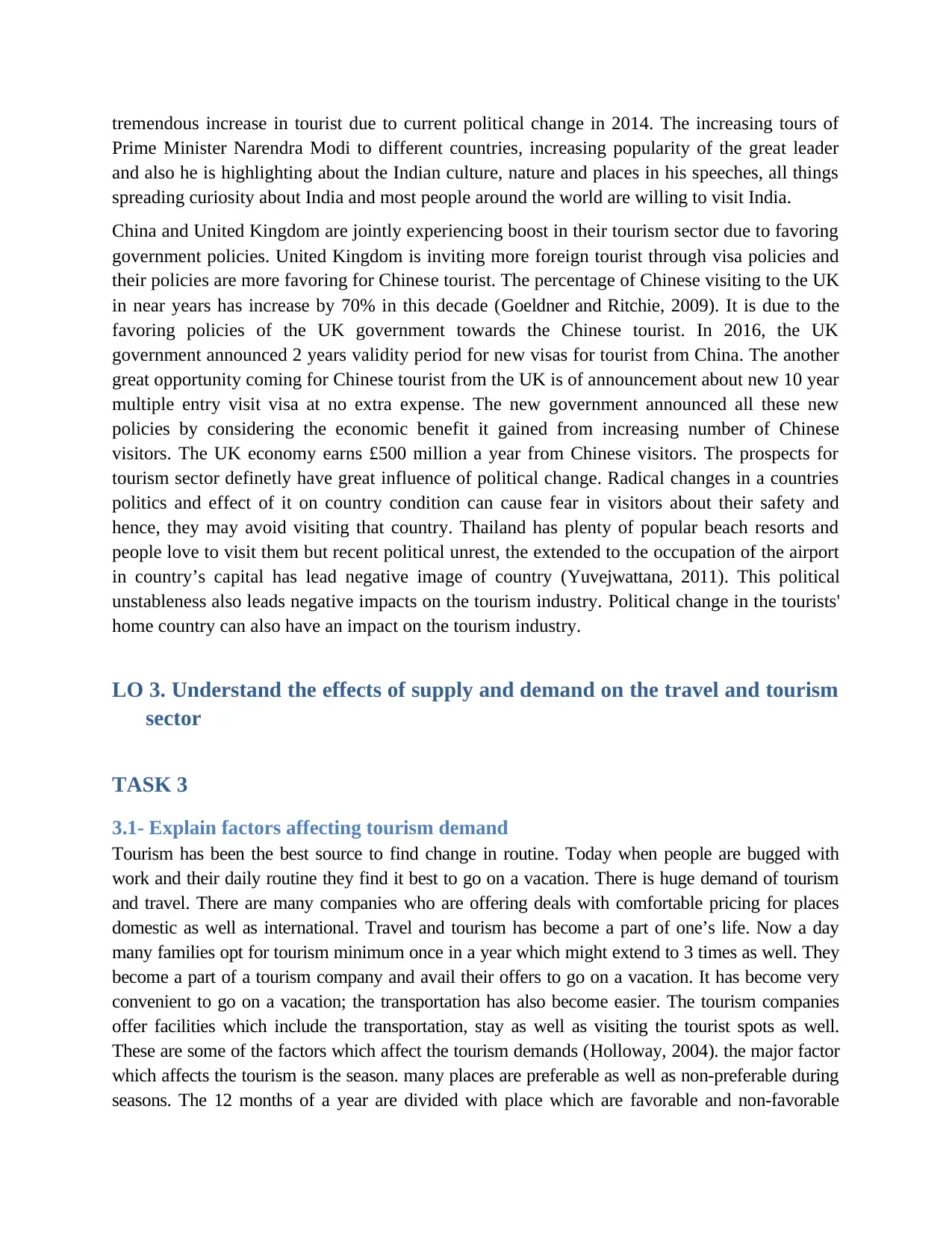
tremendous increase in tourist due to current political change in 2014. The increasing tours of
Prime Minister Narendra Modi to different countries, increasing popularity of the great leader
and also he is highlighting about the Indian culture, nature and places in his speeches, all things
spreading curiosity about India and most people around the world are willing to visit India.
China and United Kingdom are jointly experiencing boost in their tourism sector due to favoring
government policies. United Kingdom is inviting more foreign tourist through visa policies and
their policies are more favoring for Chinese tourist. The percentage of Chinese visiting to the UK
in near years has increase by 70% in this decade (Goeldner and Ritchie, 2009). It is due to the
favoring policies of the UK government towards the Chinese tourist. In 2016, the UK
government announced 2 years validity period for new visas for tourist from China. The another
great opportunity coming for Chinese tourist from the UK is of announcement about new 10 year
multiple entry visit visa at no extra expense. The new government announced all these new
policies by considering the economic benefit it gained from increasing number of Chinese
visitors. The UK economy earns £500 million a year from Chinese visitors. The prospects for
tourism sector definetly have great influence of political change. Radical changes in a countries
politics and effect of it on country condition can cause fear in visitors about their safety and
hence, they may avoid visiting that country. Thailand has plenty of popular beach resorts and
people love to visit them but recent political unrest, the extended to the occupation of the airport
in country’s capital has lead negative image of country (Yuvejwattana, 2011). This political
unstableness also leads negative impacts on the tourism industry. Political change in the tourists'
home country can also have an impact on the tourism industry.
LO 3. Understand the effects of supply and demand on the travel and tourism
sector
TASK 3
3.1- Explain factors affecting tourism demand
Tourism has been the best source to find change in routine. Today when people are bugged with
work and their daily routine they find it best to go on a vacation. There is huge demand of tourism
and travel. There are many companies who are offering deals with comfortable pricing for places
domestic as well as international. Travel and tourism has become a part of one’s life. Now a day
many families opt for tourism minimum once in a year which might extend to 3 times as well. They
become a part of a tourism company and avail their offers to go on a vacation. It has become very
convenient to go on a vacation; the transportation has also become easier. The tourism companies
offer facilities which include the transportation, stay as well as visiting the tourist spots as well.
These are some of the factors which affect the tourism demands (Holloway, 2004). the major factor
which affects the tourism is the season. many places are preferable as well as non-preferable during
seasons. The 12 months of a year are divided with place which are favorable and non-favorable
Prime Minister Narendra Modi to different countries, increasing popularity of the great leader
and also he is highlighting about the Indian culture, nature and places in his speeches, all things
spreading curiosity about India and most people around the world are willing to visit India.
China and United Kingdom are jointly experiencing boost in their tourism sector due to favoring
government policies. United Kingdom is inviting more foreign tourist through visa policies and
their policies are more favoring for Chinese tourist. The percentage of Chinese visiting to the UK
in near years has increase by 70% in this decade (Goeldner and Ritchie, 2009). It is due to the
favoring policies of the UK government towards the Chinese tourist. In 2016, the UK
government announced 2 years validity period for new visas for tourist from China. The another
great opportunity coming for Chinese tourist from the UK is of announcement about new 10 year
multiple entry visit visa at no extra expense. The new government announced all these new
policies by considering the economic benefit it gained from increasing number of Chinese
visitors. The UK economy earns £500 million a year from Chinese visitors. The prospects for
tourism sector definetly have great influence of political change. Radical changes in a countries
politics and effect of it on country condition can cause fear in visitors about their safety and
hence, they may avoid visiting that country. Thailand has plenty of popular beach resorts and
people love to visit them but recent political unrest, the extended to the occupation of the airport
in country’s capital has lead negative image of country (Yuvejwattana, 2011). This political
unstableness also leads negative impacts on the tourism industry. Political change in the tourists'
home country can also have an impact on the tourism industry.
LO 3. Understand the effects of supply and demand on the travel and tourism
sector
TASK 3
3.1- Explain factors affecting tourism demand
Tourism has been the best source to find change in routine. Today when people are bugged with
work and their daily routine they find it best to go on a vacation. There is huge demand of tourism
and travel. There are many companies who are offering deals with comfortable pricing for places
domestic as well as international. Travel and tourism has become a part of one’s life. Now a day
many families opt for tourism minimum once in a year which might extend to 3 times as well. They
become a part of a tourism company and avail their offers to go on a vacation. It has become very
convenient to go on a vacation; the transportation has also become easier. The tourism companies
offer facilities which include the transportation, stay as well as visiting the tourist spots as well.
These are some of the factors which affect the tourism demands (Holloway, 2004). the major factor
which affects the tourism is the season. many places are preferable as well as non-preferable during
seasons. The 12 months of a year are divided with place which are favorable and non-favorable
⊘ This is a preview!⊘
Do you want full access?
Subscribe today to unlock all pages.

Trusted by 1+ million students worldwide
1 out of 18
Related Documents
Your All-in-One AI-Powered Toolkit for Academic Success.
+13062052269
info@desklib.com
Available 24*7 on WhatsApp / Email
![[object Object]](/_next/static/media/star-bottom.7253800d.svg)
Unlock your academic potential
Copyright © 2020–2025 A2Z Services. All Rights Reserved. Developed and managed by ZUCOL.





